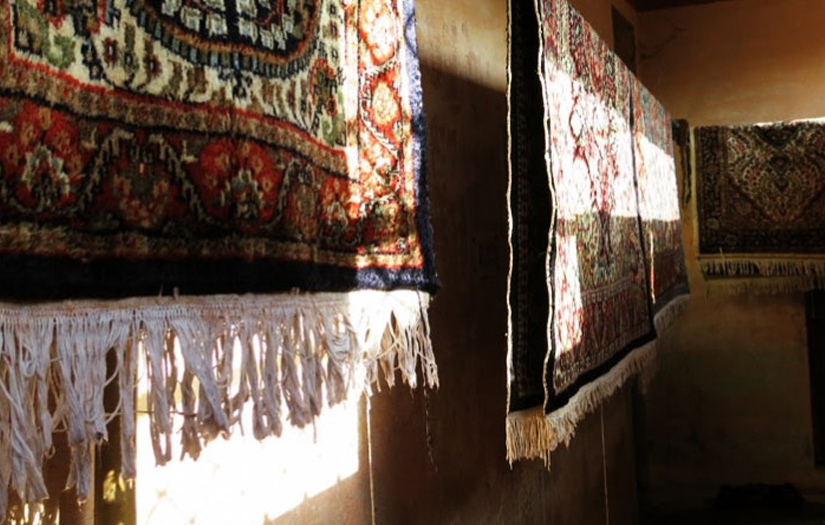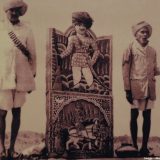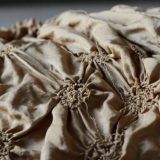An art that can sweep you off your feet

Woven carpets – a rich woven textile that is designed to adorn the naked floor till it almost ends up embracing the entire household through an unmistakable appeal of luxury. It sometimes comes packed with super powers to transport you to a world of an Arabian reverie, accessible only to fictitious fantasy characters on flying sprees. When it’s not busy doing earthly chores, a Gwalior carpet can really become a neighbor’s envy and an owner’s pride.

Madhya Pradesh being the geographic heart of the country has always been the nucleus for the blending of varied cultural bloods. The invaders who caressed this glorious soil in a bid to conquer it dropped some of their indigenous seeds. These seeds then grew into trees with roots spread deep into the Indian soil and branches farfetched to wrap an entire race in its artistic fervor. Gwalior might have been ruled by the Moguls once in the history of time, but the Persian flavor they brought along with them exists in the aesthetic sensibilities of this region even today.

The influence of the Persian style emerges strongly in the vocabulary of motifs and the choice of colors used by the artisans. Even the British who later established the East India Company in this region couldn’t stop themselves from relishing this rich and exclusive flavor. They hence established the Oriental Carpet Manufacturing (OCM) Company in the early decades of 1900’s to utilize the business potential of this industry. Since then this craft has become the locus of creative influences from different cultures within the circumference of local heritage.

40 year old Chandra Prakash Prajapati is a master craftsman who is more than merely passionate about the dexterous craft of carpet weaving since 1997. He confesses that it would be impossible to pull off the herculean task single handedly and is hence assisted by his brother and son while at work. The whole weavers’ community however deserves profound credit for sensitively and responsibly translating traditional themes into contemporary designs without diluting their bonds with the vast reserve of the ancestral patterns.

The raw materials required for this craft are wool, which is sourced from Bikaner and Amritsar, the viscose comes from Panipat & Surat and the cotton is brought from Haryana. The unique patterns and styles of carpets made in Gwalior possess a distinct vocabulary of flowers, leaves and other design motifs inspired from nature. These floral designs are more popular as compared to rugs with geometric patterns.

As the carpet evolves through different stages, it assumes an admirable number of expressions. The master craftsmen themselves draft all the designs for the carpet. The craftsmen initiate the process of design by sketching the design on graph paper, ensuring that the underlying grid remains as the reference throughout, even as details of colors and shades are drafted on the same. The designs are mostly symmetrical and are deciphered on the loom where they materialize into pixilated patterns through knotting. Warp for at least two to three copies of carpets of a singular design is stretched on the loom.

The looms used in the weaving process are vertical. The threads are aligned on the warp first. Two to three people work simultaneously on the loom and tie the threads into meticulous knots. Once the knots are tied, the excess thread is chopped off. These knots are known as Persian knots after the their place of origin.

A spectacle peculiar to this workspace is that of two people sitting against each other, as the loom stands tall between them like a wall of ever changing transparencies.The two ensure that the conversations are woven between them in tandem. This becomes increasingly necessary as the designs are inherently symmetrical. The conversations start when one of the weavers looks into the graph paper and announces a term that the person on the other side of the loom repeats as he executes the same step. The terms include words such as Byayi (meaning the color that lies below needs to be repeated on the top) and Bachcha (indicates the knot that comes on the right side of the line below needs to be repeated), Chala (indicates that the thread in front needs to be worked on eg. chala lal, chala neela etc)

To ensure that the threads are firmly positioned in the matrix of weaving, the craftsmen deliberately press them using a comb like instrument called panja, which render the woven fabric strong while introducing new rows of knots. Patti is another tool that is used to beat the carpet so that all the knots and threads settle down. Other locally invented apparatus such as dhoori is used to cut off the excess thread after weaving. However, now there is a mechanical facility to do the same by cutting all the threads to a uniform size.

The woven carpets are then dipped for 8-10 hours in water, making all the knots settle down homogeneously. The fabric is washed and cleaned with chemicals. It is later sanded using tools like ‘faavada’ till the surface becomes even. Dyeing is an essential part of the process, as these carpets are ubiquitously known for the plethora of colors traditionally obtained from natural pigments. Today despite having the facility to dye the threads using natural and synthetic dyes, the craftsmen prefer ordering previously colored fiber as it saves them time and labor.

These carpets are most popularly used for décor and furnishings in interiors. The people in the colder countries prefer hanging these carpets over the walls of their timber houses so that they double up as insulating agents.
The craft of carpet weaving in Gwalior has engulfed an incredible population including few thousand men and women in its weaves. A lot of them prefer to work with families within their courtyards.The demographics of those involved in this traditional craft currently involves a substantial Muslim population.

Most of the designs are original creations of the master craftsmen. There are also a significant number of established designers and furnishing houses that get their designs executed through the skilled artisans here. These hand woven carpets are exported to US, Canada and many other places world over.
The craftsmen believe that for a task as pedantic and painstakingly meticulous as this, where a single error could mean repeating the entire complex co-ordination all over again, there is very little value for labor, which raises a big monetary concern. Another challenge that threatens the sustainability of carpet weaving in Gwalior is that children below the age of 14 are not authorized to start working at their family looms or at least until they have attained their basic education. So, when children do join after this age, they already have their interests set elsewhere and are hardly keen on continuing.

Maybe the Gwalior carpets (which statistics suggest are only second best to the Kashmiri ones) do not come with any potential magic manuals or post usage jet lag inventory but the divine beauty of human skill that goes into meticulously building an empire of synchronized weaves is enough to transfer one into the world of delightful dream like bliss.
Read more About Carpet weaving ~ Gaatha.org










